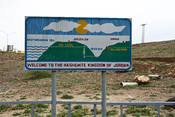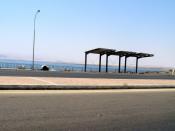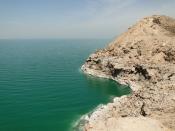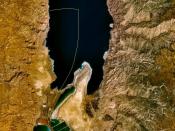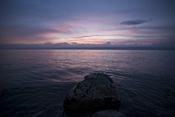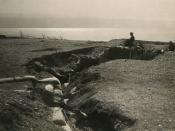1. Five points the biblical commentary makes on Psalm 23 are: A. My shepherd: God as good shepherd is common in both the Old Testament and the New Testament.
B. The right path: connotes "right way"ÃÂ and "way of righteousness."ÃÂ C. A dark valley: a different division of Hebrew consonants yields the translation "the valley of the shadows of death"ÃÂ D. You set a table before me: this expression occurs in an exodus context in Ps 78, 19. As my enemies watch: my enemies see that I am God's friend and guest.
E. Oil: a perfumes ointment made from olive oil, used especially at banquets.
2. Alexandria (Egypt), city and major seaport in northern Egypt, in the Nile River delta, on a ridge that separates Lake Maryo from the Mediterranean Sea. The city was founded in 332 BC by Alexander the Great, king of Macedonia, who planned it as one of the finest ports of the ancient world.
A mole (breakwater made of large stones or masonry) nearly 1.6 km (1 mi) in length called the Heptastadium ("seven furlongs"ÃÂ) was built to the island of Pharos, enclosing a spacious harbor. A famous lighthouse, considered one of the Seven Wonders of the World, was also built on Pharos. Another smaller harbor was open to the west. A canal joined Lake Maryo to a nearby branch of the Nile.
Nineveh (ancient Ninua), ancient city, capital of the Assyrian Empire at its height (about 705-612 BC), on the Tigris River in northern Iraq, opposite the modern city of Mosul (Al Mawsil). Today, its location is marked by two large mounds, Kuyunjik and Nebi Yunus, and the remains of the city walls (about 12 km/7.5 mi in circumference). Situated at the confluence of the Tigris and Khosr, Nineveh was an important junction for commercial routes crossing the Tigris. It was first settled in Neolithic times before 6000 BC and was inhabited almost without a break until after AD 1500.
Babylon (ancient city) (Babylonian Bab-ilim or Babil, "gate of God"ÃÂ), one of the most important cities of the ancient world, whose location today is marked by a broad area of ruins just east of the Euphrates River, 90 km (56 mi) south of Baghdad, Iraq. Babylon was the capital of Babylonia in the 2nd and 1st millennia BC. In antiquity the city profited from its location extending across the main overland trade route connecting the Persian Gulf and the Mediterranean.
Jericho (Arabic Ar, Hebrew Yiro), town in the West Bank, located in the Jordan Valley, north of the Dead Sea and west of the Jordan River. Jericho is the world's oldest known settlement and is famous in biblical history. From 1967 to 1994 Jericho was occupied and administered by Israel. In 1994 it became the first town in the West Bank to come under Palestinian administration.
3. Dead Sea, salt lake in southwestern Asia. Bounded on the west by Israel and the West Bank and on the east by Jordan, the Dead Sea forms part of the Israeli-Jordanian border. The surface of the Dead Sea, at 400 m (1312 ft) below sea level, is the lowest water surface on earth. The lake is 76 km (47 mi) long and has a maximum width of about 16 km (about 10 mi); its area is about 1049 sq km (about 405 sq mi). The Dead Sea occupies a north portion of the Great Rift Valley. On the east the high plateau of Moab rises about 1340 m (about 4400 ft) above the sea; on the west the plateau of Judea rises to half that height. From the eastern shore a peninsula juts out into the lake. To the south of this peninsula the lake is shallow, less than 6 m (less than 20 ft) deep; in the north it reaches its greatest depth of 399 m (about 1309 ft) below surface level, and 799 m (about 2621 ft) below sea level.
The Dead Sea is fed mainly by the Jordan River, which enters the lake from the north. Several smaller streams also enter the sea, chiefly from the east. The lake has no outlet, and the heavy inflow of fresh water is carried off solely by evaporation, which is rapid in the hot desert climate.
Nearly seven times as salty as the ocean, the Dead Sea contains at a depth of 305 m (1000 ft) some 27 percent solid substances: sodium chloride (common salt), magnesium chloride, calcium chloride, potassium chloride, magnesium bromide, and many other substances. Because of the density of solids in the water, the human body easily floats on the surface. The lake contains no life of any sort except for a few kinds of microbes; sea fish put into its waters soon die.
The Dead Sea is economically important as a source of potash, bromine, gypsum, salt, and other chemical products, which are extracted inexpensively. The shores of the Dead Sea are of growing importance as a winter health resort. The lake is closely associated with biblical history; the sites of the cities of Sodom and Gomorrah are believed to lie beneath the lake.
4. Exodus 21:8 Exodus 21 Exodus 21:7-9 If she does not please the master who has selected her for himself, he must let her be redeemed. He has no right to sell her to foreigners, because he has broken faith with her
